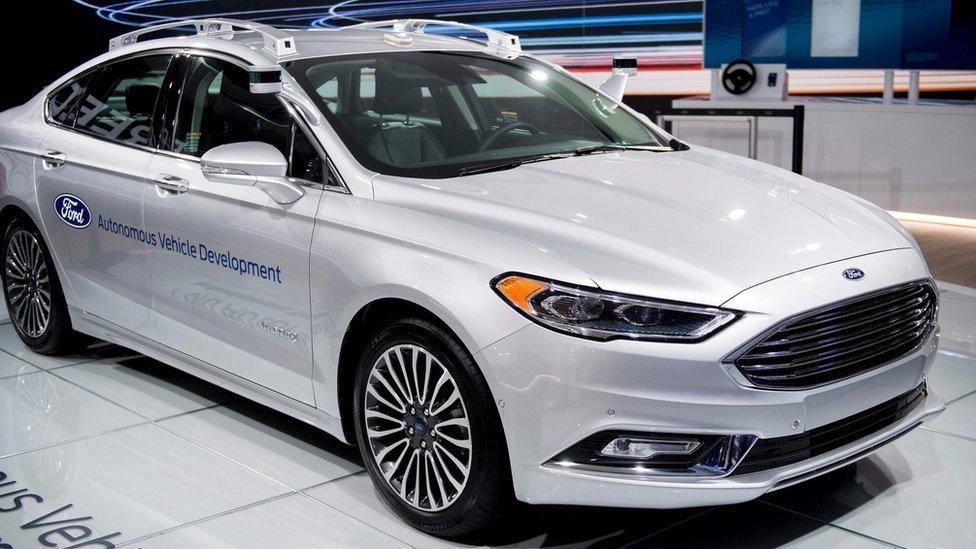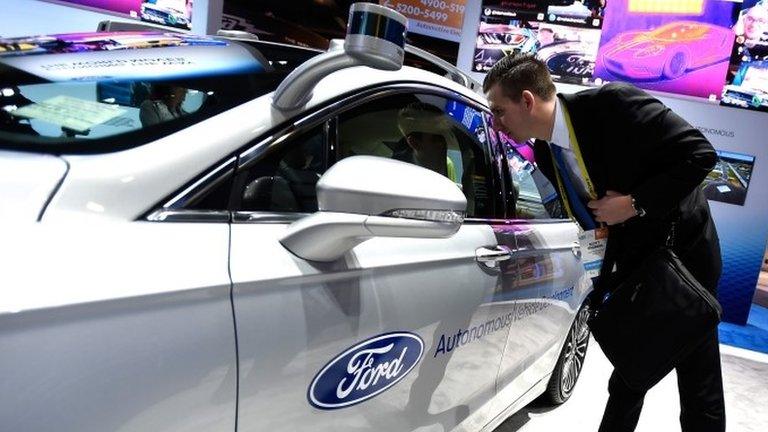Driverless cars - no halfway house?
- Published
- comments

Ford is developing autonomous vehicles
The progress in driverless car technology over recent years has been astounding. A future when you can hop in and have a sleep while an autonomous vehicle takes you to your destination appears to be closer than anyone thought just five years ago.
Getting there, however, will involve quite a few stages, with cars getting more and more autonomous but human drivers still having some role. Or will it?
A report by Bloomberg, external says Ford is going to skip a step and go straight to fully autonomous driving. The article says that is because engineers who are testing the company's self-driving vehicles are falling asleep at the wheel because there is so little for them to do.
Ford tells me that only part of this story is true: "Reports that Ford engineers were falling asleep while testing autonomous vehicles are inaccurate."
But it goes on to say that "high levels of automation without full autonomy capability could provide a false sense of security".
That means it is difficult for the driver to suddenly take control if there is a situation where the technology is not up to it. And that's why it is going to head straight to what is known as SAE level four - "autonomous capability that will take the driver completely out of the driving process in defined areas".
SAE is a global organisation of automotive engineers, external that has come up with a definition of six levels of automation, from zero - where the driver is in full control - to five, where the car does everything in all circumstances.
In January, at CES in Las Vegas, Ford's Ken Washington told me confidently that the company would have a fully autonomous car on the road by 2021: "The vehicles we are going to put in our 2021 fully autonomous ride service will not have a steering wheel, they won't have a brake pedal," he explained.
"So this means there's no issue with drivers having to take over control because the vehicle will know how to handle all scenarios."
Building up trust
Most of the car industry seems to believe that the evolution of automation will be a more gradual affair, with drivers slowly learning to trust their cars to do ever more. But I can see why Ford sees a problem with a halfway house, where the driver only occasionally needs to take over.
Last year, I drove a Tesla in Autopilot mode down an American freeway - and found it a nerve-wracking experience. My hands hovered over the steering wheel and my foot over the brake, ready to act if needed. As the technology improves, perhaps we will get more relaxed about taking our hands off the wheel, eating a sandwich or watching a video - but that could then make us less capable of responding quickly when we need to take over.
That is why Ford wants to move swiftly to full autonomy - but is that practical? I caught up with a leading British figure in this field, Professor Paul Newman, whose Oxbotica firm is developing autonomous vehicles.

Google's autonomous cars look less conventional
He thought Ford was serious about that 2021 target but stressed that what it was promising was not a car that would drive itself anywhere but what he called "mobility as a service". The vehicles would be owned by the company and would operate as a sort of autonomous taxi: "It would be a limited service on specific routes. Just like a bus can't go anywhere, you would only operate this where you were confident that it would work."
Professor Newman believes that we will first see fully autonomous vehicles operating at quite slow speeds in cities rather than on motorways. "The trick is then to have the machines learn through use and ever expand their domains."
So we have two competing strategies. Most of the car industry is looking to build ever more autonomous capabilities into something that will still look like a traditional car, in the expectation that it will take until 2030 to reach the full autonomy of SAE level five.
But both Ford and Google seem confident that building vehicles that won't look so familiar will get them to level four - full autonomy in defined areas. They hope that will change the way we think about road transport far more quickly. Let battle commence...
- Published7 January 2017
